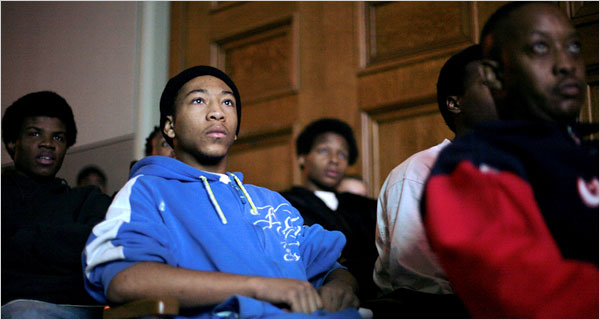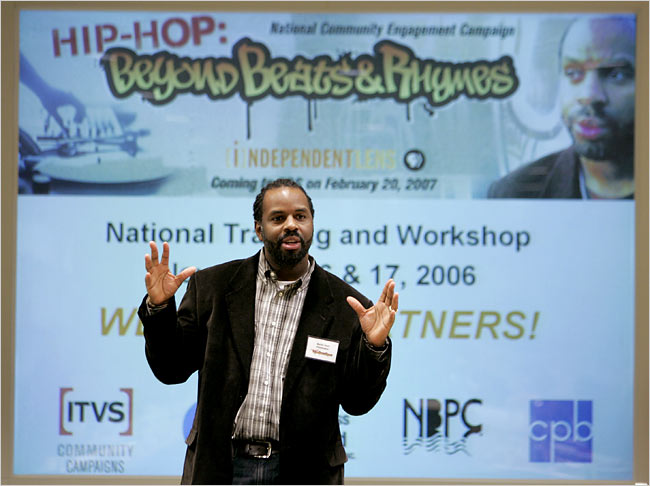| Want to send this page or a link to a friend? Click on mail at the top of this window. |
| Posted December 26, 2006 |
Fans Ask Hard Questions About Rap Music |
|
 |
|
Sally Ryan for The New York Times |
|
| James Marble, 17, center, watches "Beyond Beats and Rhymes," a documentary film by Bryon Hurt, at a screening in Chicago. |
____________ |
|
By ERIK ECKHOLM |
CHICAGO — Byron Hurt takes pains to say that he is a fan of hip-hop, but over time, says Mr. Hurt, a 36-year-old filmmaker, dreadlocks hanging below his shoulders, “I began to become very conflicted about the music I love.”
A new documentary by Mr. Hurt, “Hip Hop: Beyond Beats and Rhymes,” questions the violence, degradation of women and homophobia in much of rap music.
Scheduled to go on the air in February as part of the PBS series Independent Lens, the documentary is being shown now at high schools, colleges and Boy’s Clubs, and in other forums, as part of an unusual public campaign sponsored by the Independent Television Service, which is based in San Francisco and helped finance the film.
The intended audiences include young fans, hip-hop artists and music industry executives — black and white — who profit from music and videos that glorify swagger and luxury, portray women as sex objects, and imply, critics say, that education and hard work are for suckers and sissies.
What concerns Mr. Hurt and many black scholars is the domination of the hip-hop market by more violent and sexually demeaning songs and videos — an ascendancy, the critics say, that has coincided with the growth of the white audience for rap and the growing role of large corporations in marketing the music.
Ronald F. Ferguson, a black economist and education expert at Harvard, said that the global success of hip-hop had had positive influences on the self-esteem of black youths but that children who became obsessed with it “may unconsciously adopt the themes in this music as their lens for viewing the world.”
With the commercial success of gangsta rap and music videos, which portray men as extravagant thugs and women as sex toys, debate has simmered among black parents, community leaders and scholars about the impact of rap and the surrounding hip-hop culture.
“There’s a conversation going on now; a lot more people are trying to figure out a way to intervene that’s productive,” said Tricia Rose, a professor of Africana studies at Brown University.
At one extreme are critics, both black and white, who put primary blame for the failures and isolation of urban black youth on a self-destructive subculture, exemplified by the worst of hip-hop. But many of those critics, Dr. Rose said, fail to acknowledge the deeper roots of the problems. At the other extreme are people who reflexively defend any artistic expression by young blacks, saying the focus must remain on the economic and political structures that hem in minorities.
“That’s the real catch,” Dr. Rose said. “The public conversation about hip-hop is pinned by two responses, neither of them productive.”
Among blacks, to criticize rap, especially in front of the wider society, is to risk being called disloyal, said William Jelani Cobb, a historian at Spelman College in Atlanta, at a recent screening of the film in Newark. But the exaggerated image of male aggression, said Dr. Cobb, who also speaks in the documentary, actually reflects male insecurity and longstanding powerlessness, while the image of women resembles that held by 19th century slave owners.
Chris Bennett, 36, took his daughters, ages 15 and 11, to see Mr. Hurt’s film in Chicago because he said he wanted them to think about the music. Mr. Bennett, a school security guard, said he saw the effects of gangsta rap in his job. “Everyone wants to be tough now,” he said. “Everyone wants to be hard, and education has taken the background.”
The event in Chicago drew some 250 people, including several high school groups. Many of the boys were skeptical about the supposed dire influences of rap. Jock Lucas, 16, hotly argued with female students about the prevalence of lyrics that denigrate women, asserting, as many of the boys did, that a girl who dressed provocatively deserved such labels and might even like them.
“I don’t think rap is a bad influence,” Jock said. “They’re just speaking about how it goes where they come from. If the people who listen go out and do these things, it’s their own fault.”
Another high school student at the Chicago event, Vasawa Robinson, 19, said rap showed “real life” and that “if you try to show a different picture, the kids won’t want to listen.” The more political, socially conscious rap, Vasawa said, was for an older generation.
Mr. Hurt’s film includes clips from a music video by the rapper 50 Cent, from his album “Get Rich or Die Tryin’, ” in which the singer re-enacts a drive-by shooting he survived and boasts in crude terms of his power and readiness to kill his enemies.
 |
Doug Mill for The New York Times |
| Bryan Hurt is showing his film at high schools and colleges. |
It also includes portions of the video “Tip Drill,” an extended fantasy of male sexual domination by the rap star Nelly, who has won praise by promoting literacy and bone marrow donations, but, as the film notes, also markets a drink called Pimp Juice.
Mr. Hurt, who grew up in a black neighborhood of Central Islip, N.Y., in modest circumstances, was quarterback of the Northeastern University football team and said he had been a fanatical “hip-hop head.”
“It was music created by people your age who looked like you , talked like you, dressed like you and weren’t apologetic about it,” he said.
His views changed, he said, when, after college, he worked in a program teaching male athletes about violence against women.
“Here’s the conflict,” Mr. Hurt said. “You still love hip-hop and you love to see the artists doing well, but then you ask, ‘What are they saying? What is the image of manhood?’ ”
White males may be major customers, Mr. Hurt said, “but it influences black kids the most.”
“They’re the ones who order their days around it,” he said, “who try to conform to the script.”
Copyright 2006 The New York Times Company. Reprinted from The New York Times, Arts, of Sunday, December 24, 2006.
| Wehaitians.com, the scholarly journal of democracy and human rights |
| More from wehaitians.com |